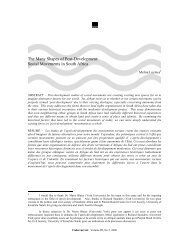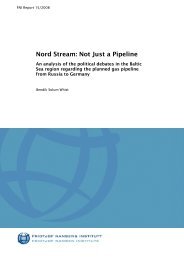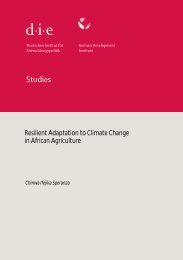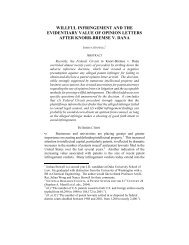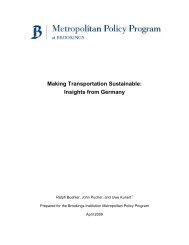equity implications of health sector user fees in tanzania
equity implications of health sector user fees in tanzania
equity implications of health sector user fees in tanzania
You also want an ePaper? Increase the reach of your titles
YUMPU automatically turns print PDFs into web optimized ePapers that Google loves.
have been highlighted <strong>in</strong> Technical Paper Part 1 and <strong>in</strong>cludes; (1) utilization and exclusion, (2)<br />
regressive outcomes <strong>of</strong> <strong>user</strong> <strong>fees</strong> on specific groups, (3) trade-<strong>of</strong>fs at household level, (4) nature <strong>of</strong><br />
payment scheme, (5) barriers other then <strong>user</strong> <strong>fees</strong>, (6) safety nets, (7) quality, (8) potential <strong>of</strong> <strong>fees</strong> at<br />
primary level, (9) adequacy <strong>of</strong> revenue generated, (10) management, (11) transparency and (12)<br />
community <strong>in</strong>volvement.<br />
2.3 Documentation on exemption and waiver systems<br />
Exemptions and waivers are so-called ‘safety nets’ which aim to protect the vulnerable and poor from<br />
the adverse impact <strong>of</strong> <strong>user</strong> <strong>fees</strong>. Most <strong>of</strong> the reviewed literature expresses a strong concern that<br />
safety nets tend to protect the poor <strong>in</strong>sufficiently from the adverse impacts <strong>of</strong> <strong>user</strong> <strong>fees</strong>. Case studies<br />
<strong>in</strong> Kenya <strong>in</strong>dicate that <strong>in</strong> 1999 waivers rarely exceeded 2 persons per month while 42% <strong>of</strong> the<br />
population was liv<strong>in</strong>g below the poverty l<strong>in</strong>e. It was also found that 80% <strong>of</strong> <strong>in</strong>patients and 86% <strong>of</strong><br />
outpatients were not aware <strong>of</strong> waivers and exemptions (Ow<strong>in</strong>o, 1998 and 1999). Evidence from other<br />
studies <strong>in</strong>dicates both leakage <strong>of</strong> benefits to <strong>in</strong>eligible households and <strong>in</strong>adequate support to the<br />
primary <strong>in</strong>tended beneficiaries (under coverage). This is <strong>of</strong>ten related to the existence <strong>of</strong> complex,<br />
unworkable and <strong>in</strong>consistent exemption mechanisms that require too much <strong>in</strong>formation and are<br />
therefore costly to adm<strong>in</strong>ister; lack <strong>of</strong> public fund<strong>in</strong>g to pay for waivers and exemptions; the lack <strong>of</strong><br />
guidance on f<strong>in</strong>ancial management and control practices; and weak adm<strong>in</strong>istrative systems. Income<br />
criteria as a reason for a waiver are difficult to apply s<strong>in</strong>ce many poor people work <strong>in</strong> the <strong>in</strong>formal<br />
<strong>sector</strong> while <strong>fees</strong> and <strong>in</strong>come eligibility thresholds are not adjusted to chang<strong>in</strong>g circumstances<br />
(Newbrander & Sacca, 1996; Gilson, 1997; Ow<strong>in</strong>o, 1998; Price, 2002; Kivumbi & K<strong>in</strong>tu, 2002, IPAR,<br />
2003; Bitran et al, 2003).<br />
Accord<strong>in</strong>g to UNICEF and Bitran (2003), the performance <strong>of</strong> exemption and waiver systems is seldom<br />
evaluated. This is considered as a major weakness as the consequences cannot be assessed and<br />
policies cannot be adjusted. Ma<strong>in</strong> constra<strong>in</strong>ts <strong>in</strong>clude; (1) exemption schemes are implemented <strong>in</strong><br />
<strong>in</strong>formal and ad hoc ways; (2) exemptions based on the ability to pay are extremely uncommon <strong>in</strong><br />
practice; (3) decisions to exempt are <strong>of</strong>ten left to the discretion <strong>of</strong> local service providers; (4) absence<br />
<strong>of</strong> specialized staff hampers the effectiveness <strong>of</strong> the waiver procedure; (5) there can be a negative<br />
attitude <strong>of</strong> <strong>health</strong> staff towards policies for protect<strong>in</strong>g the poor as waivers mean less <strong>in</strong>come and more<br />
work; (6) the distribution <strong>of</strong> cards for a waiver or exemption are <strong>of</strong>ten cumbersome and lead to high<br />
adm<strong>in</strong>istrative costs, delay and retention <strong>of</strong> cards, (7) f<strong>in</strong>ancial <strong>in</strong>centives or staff performance are<br />
l<strong>in</strong>ked to successfully collect<strong>in</strong>g <strong>fees</strong>; (8) the characteristics <strong>of</strong> the poor are generally not def<strong>in</strong>ed <strong>in</strong> a<br />
clear fashion. The lack <strong>of</strong> clear identification criteria seems to be a major problem; (9) poor people do<br />
not know about exemptions or do not bother because <strong>of</strong> adm<strong>in</strong>istrative barriers; and (10) exemption<br />
schemes can be stigmatis<strong>in</strong>g and dehumanis<strong>in</strong>g.<br />
Positive experiences that improved <strong>equity</strong> allocations <strong>of</strong> <strong>health</strong> services for poor people were found <strong>in</strong><br />
Cambodja were an Equity Fund (EF) <strong>of</strong> the National Hospital f<strong>in</strong>anced the cost <strong>of</strong> <strong>health</strong> services<br />
(consultation and medic<strong>in</strong>es) at no charge or reduced prices to the poor. A key factor <strong>of</strong> the EF that<br />
was beneficial to the poor was the payment <strong>of</strong> <strong>health</strong> providers for the services delivered. This made<br />
<strong>health</strong> providers <strong>in</strong>different towards treat<strong>in</strong>g regularly pay<strong>in</strong>g patients and EF beneficiaries. Other best<br />
practises have been <strong>in</strong>cluded <strong>in</strong> Technical Paper Part 1.<br />
2.4 Documented f<strong>in</strong>d<strong>in</strong>gs on Community Health Funds<br />
Community Health Funds and limited understand<strong>in</strong>g <strong>of</strong> <strong>in</strong>teraction with other <strong>health</strong> care f<strong>in</strong>anc<strong>in</strong>g<br />
schemes<br />
Community Health Funds (CHFs) are a form <strong>of</strong> community-based <strong>health</strong> <strong>in</strong>surance. Community Health<br />
Funds (CHFs) or Community-Based Health Insurance schemes (CBHI) are <strong>of</strong>ten mentioned as ‘the<br />
solution’ for the problems generated by <strong>user</strong> <strong>fees</strong>. CBHI schemes, where they have been operated<br />
successfully, have <strong>of</strong>fered benefits to the poor. However, the very poor require special arrangements<br />
to enable them to access benefits under the scheme (e.g. subsidies from government or higher<br />
<strong>in</strong>come scheme members); few schemes have effectively implemented these arrangements. A recent<br />
paper (Bennett 2004:147-157), emphasizes that there is actually very limited understand<strong>in</strong>g <strong>of</strong> how<br />
CBHI schemes <strong>in</strong>teract with other elements <strong>of</strong> a <strong>health</strong> care f<strong>in</strong>anc<strong>in</strong>g scheme. S<strong>of</strong>ar there has only<br />
been marg<strong>in</strong>al analysis <strong>of</strong> the impact <strong>of</strong> the CBHI scheme on the population at large and the possible<br />
effects <strong>of</strong> the schemes beyond their members. There are virtually no studies that have discussed<br />
CBHI schemes from a system-wide perspective. CBHI schemes cover a bewilder<strong>in</strong>g variety <strong>of</strong> benefit<br />
Equity Implications <strong>of</strong> Health Sector User Fees <strong>in</strong> Tanzania 5






